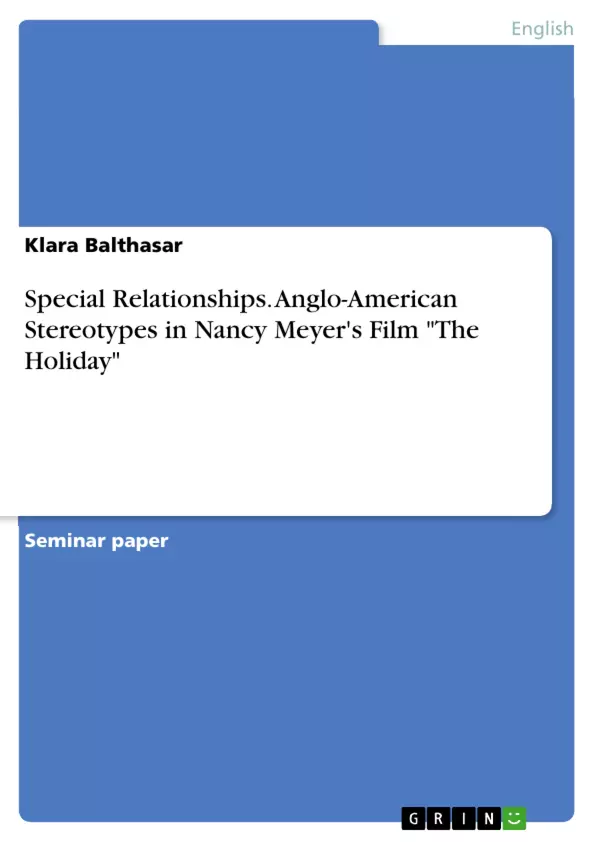'The Holiday' is a romantic comedy that tells the story of two women who change their love lives by changing their homes. However, this paper does not deal with amorous involvements and personal happy endings; it aims to analyse the various Anglo-American stereotypes that are used in the film and what they can tell us about the special relationship between the USA and the UK. In order to do so, some general information about the film and its historic context will be given. Following this, there will be a short plot summary. Then, the paper will examine which Anglo-American stereotypes are displayed by the characters and the settings. To end with, two major cultural differences between the USA and the UK will be discussed.
Table of Contents
- Introduction
- About the Film
- General Information
- Historic Context
- Plot summary
- Anglo-American Stereotypes in the Film – Characters and Setting
- The American Characters
- Amanda Woods
- Miles Dumont
- Arthur Abbott
- The British Characters
- Iris Simpkins
- Graham Simpkins
- The Setting
- California
- Amanda's Mansion
- Surrey
- Iris' Cottage
- The American Characters
- Anglo-American Contrasts
- Hollywood's Film Industry vs. England's Literary Tradition
- Modernity vs. Tradition
Objectives and Key Themes
This paper aims to analyze the Anglo-American stereotypes portrayed in Nancy Meyers’ romantic comedy film, “The Holiday.” The paper explores how these stereotypes contribute to understanding the special relationship between the USA and the UK. The key themes include:- Anglo-American stereotypes as depicted through characters and settings.
- The American auto-stereotypes, particularly focusing on the portrayal of Amanda Woods, Miles Dumont, and Arthur Abbott.
- The British hetero-stereotypes, as viewed from the American perspective.
- Contrasting cultural differences between the USA and the UK, with a specific focus on Hollywood’s film industry versus England’s literary tradition and modernity versus tradition.
Chapter Summaries
The introduction outlines the paper's objective and scope, focusing on analyzing Anglo-American stereotypes in the film. The second chapter provides general information about “The Holiday,” including its release date, director, cast, and awards. The third chapter delves into the film's historical context, particularly the strained relationship between the USA and the UK in 2006, though the film doesn’t explicitly address these political tensions. The fourth chapter offers a brief plot summary, introducing the two main characters, Amanda and Iris, and their decision to swap homes for the Christmas holidays. It highlights their individual struggles and the eventual romantic encounters they experience in their respective new environments. The fifth chapter focuses on the Anglo-American stereotypes presented through the characters and settings of the film. It examines the American characters – Amanda, Miles, and Arthur – and how they embody various stereotypical aspects of American culture. The chapter also delves into the portrayal of the British characters, Iris and Graham, as seen from the American perspective. The sixth chapter focuses on the film's depiction of contrasting cultural differences between the USA and the UK. It explores the stereotypes associated with Hollywood’s film industry versus England’s literary tradition and modernity versus tradition.Keywords
The key terms and concepts in this paper include Anglo-American stereotypes, auto-stereotypes, hetero-stereotypes, American culture, British culture, special relationship, Hollywood, film industry, literary tradition, modernity, tradition, and “The Holiday.”- Quote paper
- Klara Balthasar (Author), 2009, Special Relationships. Anglo-American Stereotypes in Nancy Meyer's Film "The Holiday", Munich, GRIN Verlag, https://www.grin.com/document/284413



